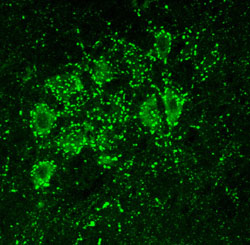
L to R: Jane Wright, research assistant; Valentina Savchenko, post-doctoral fellow; Randy Blakely, Ph.D.; and graduate student Shawn Ferguson. Dana Johnson
Findings pave way for new Alzheimer’s therapies

Randy Blakely, Ph.D. and colleagues demonstrated that the choline transporter protein is present inside nerve cell terminals, pictured here as bright green dots. The terminals in this preparation are making contact with brainstem neurons. Image courtesy of Randy Blakely, Ph.D.
The handful of prescription drugs currently approved to slow the progression of mild to moderate Alzheimer’s disease all work the same way — by enhancing levels of the neurotransmitter acetylcholine. This nervous system chemical and the “cholinergic” pathways it activates are important not only for higher cognitive functions like learning and memory, but also for motor control and modulation of the heart, digestive and endocrine systems.
“Investigators continue to search for new ways to manipulate cholinergic neurons or their targets, since we know that they play such critical roles in behaviors as fundamental as movement, learning and memory,” said Randy D. Blakely, Ph.D., Allan D. Bass Professor of Pharmacology and director of the Center for Molecular Neuroscience.
Blakely and colleagues report in the Oct. 29 Journal of Neuroscience that the choline transporter — a protein required for the synthesis of acetylcholine — “hides out” inside the neuron and is mobilized as needed by active signaling. The findings pave the way for new strategies to enhance cholinergic function in Alzheimer’s disease and other disorders that involve cholinergic loss, Blakely said.
The choline transporter acts as a molecular vacuum cleaner, sucking choline from the synapse into the releasing neuron, where it can be made into more acetylcholine. It has long been recognized that choline supply is the limiting factor in acetylcholine synthesis, Blakely said.
“The choline transporter is the key protein that controls acetylcholine production. If you don’t make acetylcholine, you die.”
The only drug that targets the choline transporter is a blocker, and it is lethal, Blakely said. “We think there’s a lot of room for developing medications that enhance choline transporter function,” he said. “In order to do that, we need to know what regulates the transporter, what limits its action.”
The investigators found that one limitation on transporter activity is its availability at the nerve cell surface. It was surprising, Blakely said, to find that the choline transporter resides inside the nerve terminal on the surface of synaptic vesicles — the packets of neurotransmitter waiting to be released. In one sense, the choline transporter is “hijacking” the neurotransmitter release machinery in order to make its way to the plasma membrane, he said.
This unusual mechanism couples neuronal activity with transporter availability, increasing choline uptake and making increased acetylcholine production possible when neuronal activity is heavy.
“If we can gain control of those pathways — once we understand them better — we should be able to induce transporter movement and enhance cholinergic function to favorable therapeutic ends,” Blakely said.
Blakely and colleagues are exploiting genetic model systems, in the worm C. elegans and in the mouse, to study choline transporter regulation. Knockout mice that lack the choline transporter die just after birth, but mice with half the normal number of transporters (mice heterozygous for the gene deletion) appear to have normal nervous systems. These mice may offer a novel opportunity for testing the ability of cholinergic drugs to restore cholinergic activity, Blakely said.
The investigators are also interested in how mutations in the choline transporter might affect susceptibility to diseases involving cholinergic loss. One genetic variant in the transporter has been reported that reduces choline transport capacity. The variant is fairly common, Blakely said, but its effects in humans are unknown.
“It raises questions as to whether some individuals might be more vulnerable perhaps to age-dependent deficits in cholinergic function because their choline transporters aren’t functioning at full capacity,” he said.
Blakely is collaborating with Dr. Stephen L. Lee, assistant professor of Neurology, and Jonathan L. Haines, Ph.D., director of the Program in Human Genetics, to study whether mutations in the choline transporter gene increase risk for Alzheimer’s or Parkinson’s disease or influence age-at-onset or therapeutic outcome of these diseases.
Shawn M. Ferguson, a graduate student in Blakely’s laboratory, is the first author of the Journal of Neuroscience paper. Other Vanderbilt authors include Valentina Savchenko and Jane Wright. The research was supported by the Vanderbilt Brain Institute, the Alzheimer Foundation and the National Institutes of Health.













